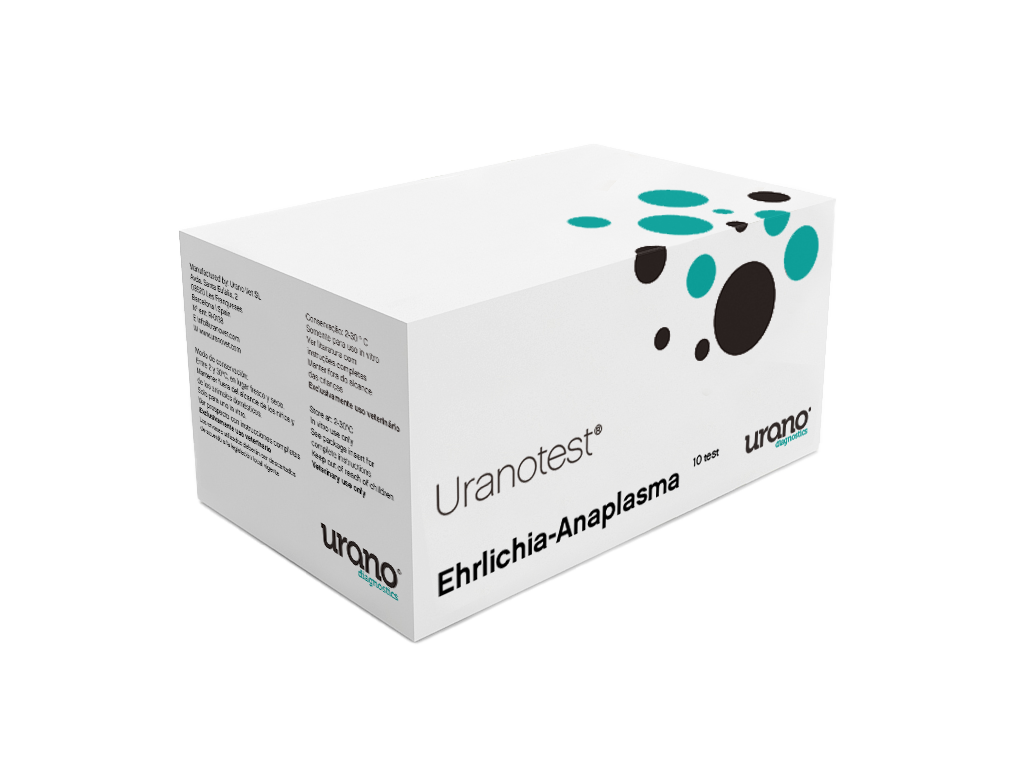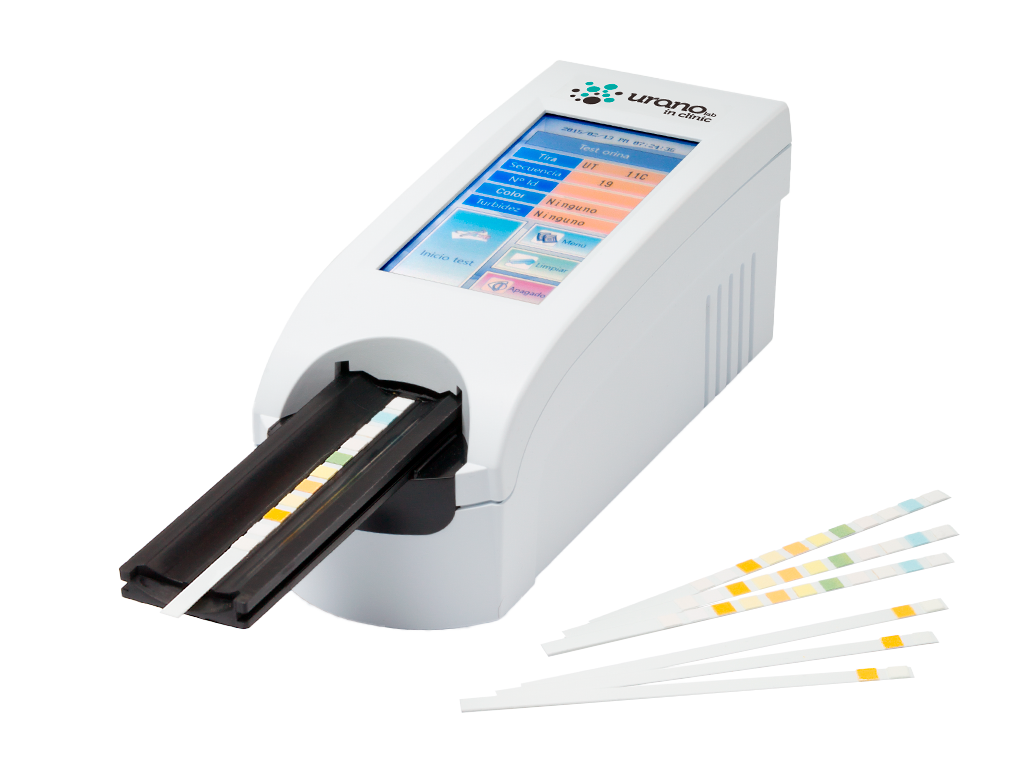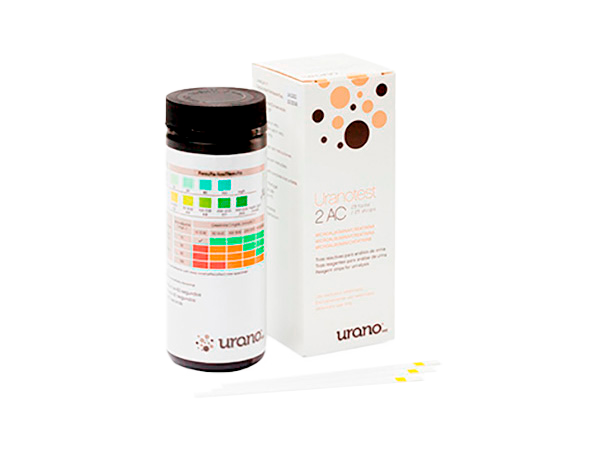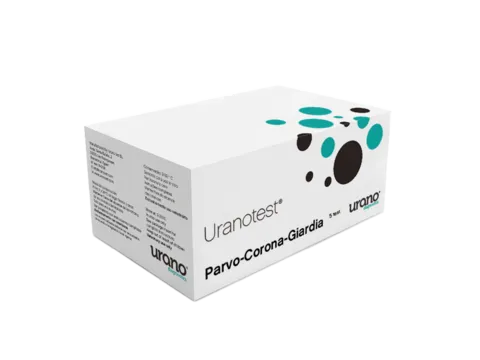
Diagnostic tests
Uranotest® Parvo-Corona-Giardia
Simultaneous detection of Parvovirus, Coronavirus and Giardia spp antigens in faeces.
Specs
- Purpose
Detection of Parvovirus, Coronavirus and Giardia spp antigen
- Sample
Faeces
- Sensitivity
- Parvovirus 100% versus hemagglutination
- Coronavirus 93% versus RT-PCR
- Giardia 100% versus microscopy
- Specificity
- Parvovirus 100% versus hemaggglutination
- Coronavirus 97,5% versus RT-PCR
- Giardia 100% versus microscopy
- Execution time
1 minute
- Presentation
Boxes of 5 and 15 tests
- Registration Nº
10400 RD
Characteristics
- Does not detect antigens of vaccination origin.
- No crossed reactions with distemper virus, infectious hepatitis, parainfluenza and intestinal parasites.
- High sensitivity.
Information for the veterinarian

- Take the samples using the swab provided, as described in the previous section. Collect the samples using 2 swabs (one for Parvovirus-Coronavirus determination and another for Giardia determination).
- Insert 1 swab into the tube containing the diluent buffer for Parvovirus and Coronavirus determination (diluent tube with blue cap identified as "dil. Parvo-Corona") and mix well for 10 seconds. If the diluted sample contains particles, wait for 1 minute until they sediment, use the supernatant.
- Insert the second swab into the tube containing the diluent buffer for Giardia determination (diluent tube with yellow cap identified as "dil. Giardia") and mix well for 10 seconds. If the diluted sample contains particles, wait for 1 minute until they sediment, use the supernatant.
- Remove the test device from the protective pouch and place it on a flat and dry surface.
- Using one of the provided pipettes, transfer 4 drops of the recently prepared sample to the round sample well, corresponding to Parvovirus strip, identified as Parvo. The sample must be added slowly, drop by drop and in an exact way.
- Repeat the same procedure for the CCV test, identified as Corona.
- Using a new pipette, transfer 4 drops of the recently prepared sample to the round sample well, corresponding to Giardia strip, identified as Giardia. The sample must be added slowly, drop by drop and in an exact way.
- When the test begins running, you will observe migration of the sample through the result window. If migration has not begun 1 minute after sample addition, add one more drop of the diluted sample.
- Read the results within 5-10 minutes. Coloured lines appeared after 20 minutes have not diagnostic value and should be ignored.
Giardiasis is undoubtedly the most common internal parasitosis in dogs. It is usually subclinical although in some cases it can cause intermittent mucoid diarrhoea or persistent diarrhoea with steatorrhoea, anorexia, vomiting, loss of appetite and listlessness.
It can sometimes present with a clinical manifestation similar to that of parvovirus or coronavirus infections and is difficult to distinguish from diarrhoea caused by these viruses.
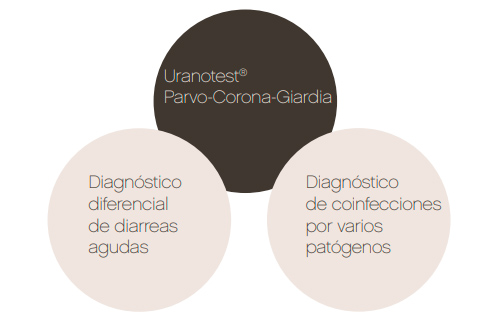
Negative result
There is only a single purple line on the C area (control line) of Parvovirus, Coronavirus and Giardia.
Positive result
Two lines appear on the result window (T and C lines).
Invalid result
The test is invalid if not coloured line appears at the Control area (C) even if a coloured line appears in the Test area (T). The reason may be due to incorrect handling or using a damaged test.
Frequently Asked Questions
The detection of Feline Panleukopenia Virus (FPV) antigen in cat feces.
Symptoms vary depending on the virulence of the virus, the host's immune status, and possible associated bacterial complications.
There are basically two clinical forms of presentation. The classic form is associated with gastroenteritis along with leukopenia, while the atypical form mainly affects neonates and presents with neurological symptoms.
There is little data available on the prevalence of the disease. Although it has significantly decreased thanks to vaccinations, it is still very common in stray cats or those from group settings, being one of the leading causes of mortality in this population.
Mortality is high, ranging from 25% to 90%, with significant variability depending on the promptness of diagnosis and treatment. Therefore, it is highly recommended to test any cat, especially if it is young, from at-risk populations, or showing symptoms compatible with the disease.
The swab provided is inserted into the anus, attempting to collect any fecal remnants that are always adhered to the walls. A small amount is enough to perform the test.
Uranotest® Feline Panleukopenia has high sensitivity and can detect very small levels of antigen, so it is not recommended to use a large amount of feces. On the contrary, if an excessive sample volume is used or if the sample contains too large particles, interference may occur in the migration process of the sample. If an excessive volume is used, mix well, wait one minute for the larger particles to settle, and take the sample from the supernatant.
The appropriate sample volume is described in the kit leaflet.
Between 5 and 10 minutes, you can read the results with full reliability.
After 10 minutes, degradation and blurring of the band colors may occur. This doesn't always happen, but the recommendation is to always repeat the test if the reading couldn't be performed within the indicated time, as it may lead to incorrect interpretation.

Uranotest® Parvo-Corona-Giardia

